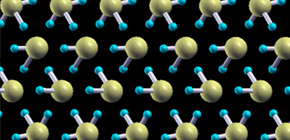
Hydrogen sulfide leading to the clarification of high-temperature superconductivity found
A step forward to the solution of environmental and energy problems using superconductivity
A group of researchers led by Specially Appointed Assistant Professor ISHIKAWA Takahiro and Professor SHIMIZU Katsuya (Center for Science and Technology under Extreme Conditions, Graduate School of Engineering Science, Osaka University), Professor ODA Tatsuki (School of Mathematics and Physics, Kanazawa University), and Professor SUZUKI Naoshi (Faculty of Engineering Science, Kansai University) predicted a new superconductivity phase of hydrogen sulfide, which was presented at a pressure of 110 Gpa on computer simulation using first - principles electronic structure calculations and the genetic algorithm technique for crystal structure searching.
Superconductivity is the total disappearance of electrical resistance when an object is cooled below a definite temperature. If superconductor is used for electric wire, it becomes possible to carry electricity without loss. That’s why superconductivity has been drawing attention as an important physical phenomenon for solving environmental and energy problems.
However, the superconducting critical temperature, the temperature at which superconductivity takes place, is so low that its practical realization is difficult. Last year, it was found that H 2 S broke the record for superconducting critical temperature under high-pressure, which was much talked about. However, the chemical composition ratio of sulfur and hydrogen and the crystal structure during the process in which superconductivity takes place have not been well understood.
This group predicted the superconducting critical temperature obtained from H 5 S 2, whose calculated value was the same as the experimental value.
Further theoretical and experimental research based on H 5 S 2 predicted by this group will lead to the clarification of the mechanism behind high-temperature superconductivity, which takes place in hydrogen sulfide.
Furthermore, by applying methods used and knowledge obtained by this group to other light element hydrides, it will become possible to establish guidelines for enhancing superconducting critical temperature to near room temperature.
Abstract
Recently, hydrogen sulfide was experimentally found to show the high superconducting critical temperature (T c ) under high-pressure. The superconducting T c shows 30–70 K in pressure range of 100–170 GPa (low-T c phase) and increases to 203 K, which sets a record for the highest T c in all materials, for the samples annealed by heating it to room temperature at pressures above 150 GPa (high-T c phase). Here we present a solid H 5 S 2 phase predicted as the low-T c phase by the application of the genetic algorithm technique for crystal structure searching and first-principles calculations to sulfur-hydrogen system under high-pressure. The H 5 S 2 phase is thermodynamically stabilized at 110 GPa, in which asymmetric hydrogen bonds are formed between H 2 S and H 3 S molecules. Calculated T c values show 50–70 K in pressure range of 100–150 GPa within the harmonic approximation, which can reproduce the experimentally observed low-T c phase. These findings give a new aspect of the excellent superconductivity in compressed sulfur-hydrogen system.

Fig. 1 a. Crystal structure of the H 5 S 2 compound predicted by genetic algorithm technique. The structure forms a mixed structure of H 2 S and H 3 S molecules. b. Comparison of superconducting critical temperature ( T c ) among experimental and calculated results. The T c value calculated for H 5 S 2 shows a good agreement with the experimental data of the superconducting phase II (SC-II).
To learn more about this research, please view the full research report entitled " Superconducting H 5 S 2 phase in sulfur-hydrogen system under high-pressure " at this page of the Scientific Reports website.
Related links
